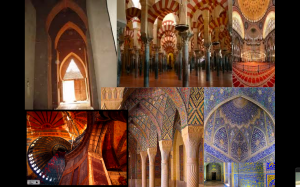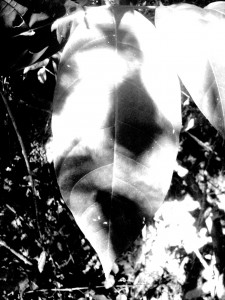Introduction
ø
My work reflects through a modern prism the diversity and depth of Islamic art. From poetry to art, dance to literature. Each creative project touches on a number of primordial themes, which go beyond the confines of any particular religion, society or period.
The transcendental quality of light, both in a figurative and metaphorical sense, is explored by black and white photography and the Haiku. It is also touched upon in the Ghazal. Key issues such as the importance of prescribed religious practice (which is especially interesting in Islam with the Sufi and conventional approaches) are expressed in the photo-collage and the illustrated short story, the later exploring this topic in relation to gender, a topic of my interest.
A common motif to all the projects is the desire for Tawheed, Union with Allah: The collage expresses this through architecture; the leaf picture alludes to the God’s imminence and presence within the entire universe. The Haiku attempts to move beyond an understanding of God based on intellectual understanding and rationality. The dance choreography and lyrics of the song express a desire for union with God who created human kind to find him. The illustrated story shows the liberation that can be achieved by following Allah’s rules and the Ghazal describes the journey of women to achieve Tawheed by experiencing the different aspects love. In the Quran, it is written that “Allah is closer to you than the jugular veins”. True to this motif, I have placed Allah at the centre of every one of these creative art mediums.
While creating each of these six different pieces, I sensed a different kind of freshness and closeness to the religion. In each of my creative pieces, I started seeing some multi facets of Islam that ran from veils to ghazal to dances.
Ghazal
Writing the ghazal gave me an outlet of expression. Initially started without any expectation of how much it was going to touch me. However, as I went on, it became a portal to connect to myself, albeit for a brief period. The beauty of its flow gave me a sense of peace. At each stage in writing this ghazal, I was encouraged by Kelly LeFave’s (Real Ghazals) description of how liberating the defined structure of the ghazal can be. I struggled to find the rhythm and rhyme for a large portion of the ghazal. For someone who does not consider herself to be very talented at singing, it was definitely a very interesting experience to go through the ghazal. I persevered and the poem eventually took a form of itself. I realized through this process that writing a ghazal does demand you to sing it at the same time as well. This is an art form that asks you to not only use your head, but also your heart and your voice at the same time. The parallel with the motifs in the course regarding the use of head and heart were not lost on me.
I was also reading about the ghazals before attempting to create them. I learnt then about the importance of idea cross pollination. Such cross pollination between Persia and India became apparent. I found it interesting that when Islam was brought to India that the culture of dance influenced the Christi Sufi order. Finally, having come from a different academic field than religion, the ghazal helped me to explore the side in me that I was not aware of its existence, my love for writing poetry.
Photography
My photography project was very much involved with the idea of light in Islam. When I learned about the importance of light in Islam, it reminded me of Hinduism. I was especially reminded of Diwali, the key Hindu festival of lights. During Deewali, families come together to light the small clay lamps with oil to signify the triumph of good over evil. Amongst the many God and Goddesses worshiped during the festival, Laxmi the Goddess of wealth is one of the central Goddesses. Laxmi is thought to be benevolent to her devotees. . There is also deeper spiritual meaning to Diwali where the importance of awareness of the inner light is celebrated. A cornerstone of Hindu philosophy is that there is something beyond the physical body and mind, which is pure infinite and eternal called aatma. This is the human soul, which is then connected to the composite soul called Brahman. I could not stop thinking about the parallel between the Aaatman-Brahman connection in Hindusim against the connection between all humankind and Allah in Islam. These ideas all arose in my head when I was thinking about the importance of light in Islam.
Dance
The dance choreography was the most enjoyable part of the project for me. I was able to work in a group and collaborate to choreograph and dance on a beautiful Qawwali song by Nusrat Fateh Ali Khan called Alla Hooin. Dance is an integral part of the Indian culture. In this particular song, we repeated many of our moves to the dance beat, Allah Hoo. This reminded me of the theme of repetition in Islam. Forgetfulness in humans is addressed by Islam by proscribing a repetition of rituals and cyclical requirements in Islamic life. Art and Architecture, another important aspect of Islamic culture, also employs repetition by the use of geometric patterns that is repeated infinitely to give a sense of timelessness and create the sense of infinite space.
Dancing together also brought a sense of community to the project. Community is a large part of many motifs of Islam. It also made the process of dancing less nerve-wracking and more fun.
Haiku
When I first wrote the haiku, I drew parallels between the haiku and Islam. I believe now that the greater parallel is between the Haiku and Ghazal. Both are art in their own forms and are gaining in recognition in the West. As a poetry form, they both liberate the poets by confining them to various artistic rules. In the Haiku, the artist is limited to five 5-7-5 syllabus whereas in the ghazal- same meter, rhyming couplets and idiosyncratic limitations.
What is interesting is actually the fact that by constricting me in the forms of what I was creating, both these forms of art allowed me the freedom to express myself. That brought questions of freedom to my head. There are many ways in which Islam sets rules for behavior for its adherents. These can be compared to constraints on the forms of behavior. Does that however mean that Islam actually allows a large degree of freedom on the expression of our interests and wishes? I could not answer the question, but the idea was interesting.
Photo Collage
On the photo collage, I have depicted the interiors of various mosques around the world ranging from mud construct in Djenne in Mali to man’s mosque in Esfahan.
Having coming from a Hindu background where there are different deities in various in temples, I get astounded with Islam where no deities exist. I understand that this is something that is a core part of the religion. According to the Quran, “No vision can grasp Him, but His grasp is over all vision. God is above all comprehension, yet is acquainted with all things” Qur’an 6:103. Maybe because of this, the interiors of mosques look very different
While researching for different kinds of mosque during my collage creation over the internet, I realized the beauty and diversity of mosques around the world. This surely has triggered my interest to visit the Islamic world and gain deeper understanding of its diverse culture and architecture.
Illustrative Story
I used the illustrative story to use my experience in India to connect with the important facets of Islam and its relationship to gender and the modern world. When I was working on the project, I started vividly remembering small details about the train trip in Mumbai I was taking last December. The wandering eyes of the men who were looking at me came back to me very clearly while I was drawing.
I also remembered the incredible feeling I had when I was wearing a hijab the next day. The freedom of not having to worry about someone looking at me was a new experience, and it helped me connect to myself more. I was reminded of this experience during Professor Assani’s lecture on gender and Islam. One of the interesting topics raised during the lecture was the contextual interpretations of the hijab, namely the question; is the veil oppressive or liberating? A quote that I found interesting was:
“Prophet! Tell your wives, your daughters and the women folk of believers to draw their veils closely around them. This will facilitate their being identified for who they are and will save them from molestation….God is forgiving and merciful.” Surah 33.59
This portfolio project has helped me to understand Islam using my head, heart and hands. By studying the art and creative forms of the Islamic World, from calligraphy to poetry to architecture, I have gained a deeper appreciation of both the diversity and depth of Islam. I believe it has been insightful to study Islam through the lens of culture as often religion lives and breathes through the rites & rituals and the wider influence on society and not just in churches, temples, synagogues and mosques.
This has been a exploration which I have thoroughly enjoyed. I hope you enjoy the creative projects, which I am sharing with you.

